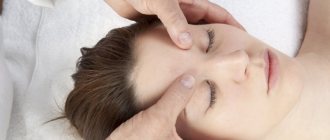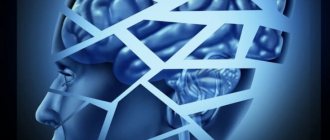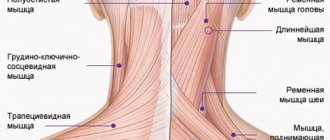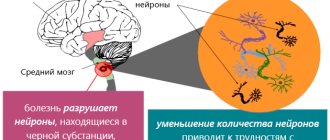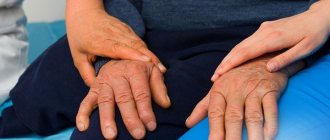Category: Psychologist's advice/ February 06, 20200
The statistics are shocking: seven out of ten Russians suffer from neuroses. Psychologists associate the state of neurosis primarily with the fact that the dynamics of life itself have changed. We are always in a hurry, worrying, fighting for a place at work and in life. Neuroses are a psychological problem primarily for residents of megacities. Psychologists are ringing bells. But how to deal with this? How to get rid of neurosis and make sure that calmness triumphs and is firmly entrenched in ourselves?
Origin and causes
The name “neurosis” originated back in 1776 during a dispute between two doctors studying mental disorders. The Italian G. Morgagni specialized in pathological anatomy. He argued that neurasthenia is a consequence of physiological changes in organs and tissues. In his opinion, the pathology could be provoked by a protracted inflammatory process, tissue degeneration, or genetic characteristics. The Italian specialist’s opponent was the Scot W. Cullen. He considered the only possible cause to be the combined influence of neuropsychic factors. It was Cullen’s opinion that turned out to be correct, and the term he proposed was included in the official list of diagnoses.
In-depth study of the issue over many years has not yielded a comprehensive definition. Psychiatry and biology give different explanations for the deviation in question. Soviet scientist Ivan Petrovich Pavlov wrote that the essence of nervousness is a prolonged overstrain of nervous processes in the brain associated with destructive external stimuli. Sigmund Freud saw the reason in the opposition of the hidden instinct to social prohibitions. American psychologist Karen Horney blamed childhood trauma. Modern experts identify several prerequisites that provoke the disease.
What is associated with the development of pathology?
Biological background
- Impaired synthesis of neurotransmitters. The activity of these substances affects the functioning of the nervous system and affects mood. Deficiency of mediators negatively affects well-being and causes depression.
- Intoxication. With prolonged negative effects of toxins, mental problems can be detected. Intoxication can occur due to the consumption of certain substances (medicines, alcohol, drugs), long-term illness, or poisoning.
- Complications of certain pathologies. It may be a consequence of other internal processes and abnormalities: a malignant or benign tumor, vitamin deficiency, damage to the nervous system of various etiologies.
Psychogenic causes
- Prolonged experience. Study stress, difficult work, excessive emotional overload, loss.
- Inability to confront problems. The catalyst for an obsessive state can be an insoluble situation (large debt, loss of position).
- Patient's personality bias. Impressiveness, regular feelings of anxiety, tendency to exaggerate and dramatize.
- Unsatisfied ambitions. Failure of events to meet expectations can be a big shock.
- Upbringing. Lack of normal relationships with parents, aggression, domestic violence.
However, it is often not possible to identify specific preconditions. In recent years, the total number of registered cases of HP has increased 25 times. The most common is obsessive-compulsive disorder. On average, severe pathology affecting the quality of life is found in every third inhabitant of the Earth.
Manifestations of obsessional neurosis
The most common manifestation of obsessional neurosis is fear, which is very difficult and sometimes almost impossible to overcome. Phobias make social contacts, work and all other aspects of life very difficult.
Another version of neurosis is, in fact, obsessive thoughts that a person cannot “drive” out of his head. These thoughts interfere with learning, concentration and greatly tire the patient. An important criterion: a person with obsessional neurosis never realizes his thoughts. The last type is compulsive. It manifests itself through obsessive movements and excessive ritualism.
Signs of deviation in neurosis
Diagnosis involves a comprehensive assessment. Treatment of neurosis is prescribed after identifying the following fundamental signs that distinguish HP:
- The leading role of psychogenic deviation in the deterioration of well-being;
- Reversibility of deviations in the nervous system;
- The picture is not complemented by signs of psychosis (obvious mental disorders, phobias);
- The person does not have dementia, personality changes do not progress;
- The patient is aware of the pathological nature of thoughts and retains critical thinking.
As a rule, with neurosis, two types of symptoms are found: mental and physiological.
Examples of obsessional neurosis
It is very easy to explain the essence of this phenomenon with examples. Let's say you believe that you shouldn't look in the mirror before leaving the house. However, if you accidentally look in the mirror, you will still leave the house without giving it much importance.
Or, for example, a black cat on the road will not force you to reschedule your business: you may be a little worried, but you will soon forget about it. A person with compulsive obsessions, looking in the mirror, will bolt the door and stay at home all day, and, having met a black cat, go to the pharmacy for sedatives.
As you can see, obsessional neurosis makes the patient’s life very difficult. This means that we can say confidently and definitely: this disease definitely needs treatment, and the treatment must be professional and complete.
Physical symptoms and signs of neurasthenia
- Headache, constant dizziness and autonomic disorders. There is a feeling of squeezing, pulsation, tingling in the temples.
- Discomfort in the chest and heart area. Compression, pain, various rhythm disturbances - tachycardia, bradycardia.
- Pain in the stomach. It may hurt, pull or twist after the experience.
- Deterioration in performance and asthenic syndromes. Weakness, fatigue. Memory and thinking suffer. Chronic feeling of fatigue.
- Nervous pressure changes associated with attacks. It becomes dark in the eyes, I can’t breathe, my head is spinning.
- Loss of coordination. Noticeable external symptoms of neurosis are clumsiness and difficulties in the functioning of the vestibular apparatus.
- Psychalgia. Painful sensations not related to physiology, but caused by anxiety.
- Deterioration in the quality of sexual life. There is a decrease in sexual desire, tension negatively affects potency.
- Speech defects. Stuttering is common.
- Change in appetite. It manifests itself individually as gluttony and refusal of food.
What mental symptoms should be considered if a disorder is suspected:
- Insomnia and difficulty falling asleep;
- Emotional distress without adequate prerequisites;
- Panic attacks, acute reactions and grievances, fear;
- Difficulty making decisions, difficulties communicating, inability to cope with stress;
- Inappropriate reactions to events - aggression or tears;
- Manifestations include incorrect self-esteem - overestimation or underestimation;
- Changes in mood, fatigue, memory loss, irritability are detected;
- ND may include dwelling on an unpleasant situation from the past;
- Inconsistency of life values, dependence of self-perception on temperature changes, loud sounds or bright light.
It is necessary to understand that symptoms do not necessarily include all of the listed events. A comprehensive assessment of manifestations followed by a diagnosis is rational.
Treatment methods for neurasthenia
The treatment tactics for neurosis are determined by the doctor depending on the severity of the pathology. In some cases, you can get rid of HP using psychotherapy alone. Properly selected psychologist activities are the fundamental technique for treating neurasthenia. The reversibility of neurosis and a positive reaction to mental influences allows you to quickly achieve healthy thinking. Based on the specifics of the methods, there are:
Pathogenic. Designed to fight the root cause. They help identify conflict, resolve internal contradictions, and mitigate childhood trauma, the consequences of which have become a pathology in adulthood. The most effective methods of therapy are: psychodynamic, systemic, cognitive, integrative.
Symptomatic. They allow you to correct behavior during stressful situations, help lay down the principles of objective perception, and independently stop panic symptoms. They use hypnotherapy, breathing techniques, and relaxing painting.
Sometimes the diagnosis requires medical intervention. Usually, drugs act as a “second fiddle” to achieve rapid physical and mental relief. These products should only be consumed under the supervision of a specialist. The drugs have a wide range of limitations and side effects.
Useful tips for those who are faced with neurosis
Finally, I would like to give the floor to those who have already answered the question “how to get rid of neurosis” and returned to a full life. These tips will certainly be useful to anyone who has encountered similar disorders and does not yet know how to cure neurosis.
- Don't take on too much. The political situation in the country, the economic crisis and even strange decisions of local authorities - you cannot influence all this in any way, so you should not be nervous or worry about this. If you find it difficult to stop the flow of indignant thoughts, just give up the TV and stop reading news on the Internet.
- Don't look for someone to blame. Shifting responsibility for your life to someone else is the position of a child, and an adult can either change the circumstances of his life or accept them and not worry about them anymore.
- Don't turn your back on problems, don't put off solving them. In fact, in life, a lot of things can be “replayed” back if something doesn’t work out, so don’t be afraid to try and make mistakes.
- Take care of yourself! Don’t wait for someone to come and pat you on the head, solve all your difficulties, help and calm you down. Each of us has the resources to take care of ourselves, all we need to do is make a decision and take action.
- If it’s hard for you, then find someone who has it even worse and help. In this way you will be able to see that your sufferings seem to many others to be only mild difficulties. And, besides, you will do a good deed for someone.
- Write a list of qualities or achievements for which you can respect yourself. If you feel that your self-esteem has suddenly dropped, carefully re-read what you have written to cheer yourself up and regain faith in yourself.
And one more important recommendation: remember that we are not fighting “with neurosis,” but “for our wonderful and happy life.” And do everything to make this life exactly like this - otherwise it will be very, very difficult for you to get rid of neurosis.
Types of drugs for relieving neurosis
- Tranquilizers. Means that reduce emotional anxiety and tension.
- Neuroleptics. Suppress psychomotor agitation, reduce the speed of the brain reaction without loss of consciousness.
- Sedatives. They calm down, relieve hysterical neurosis, and normalize the emotional background.
- Antidepressants. Increases the level of neurotransmitters. This is the main way to combat depression using pills.
When conducting therapy among adults and children, light therapy, long walks in the fresh air, and communication with loved ones are recommended. It is good if the patient is engaged in some activity with pleasure, for example, creativity or handicrafts.
Features of the course in men
Neurosis occurs differently in all people. In women, the hysterical variety is more often found. Characterized by unstable behavior, dramatization of situations, tears and screams. Symptoms when treating neurosis in men who require treatment are somewhat different. They are less likely to encounter a diagnosis, but more often progress the condition to its extreme stages. In representatives of the stronger sex, the diagnosis is often associated with overexertion and workaholism. Common features include:
- Aggression. Reactions to familiar things become acute. A man responds to everyday events with anger.
- Low self-esteem. A person does not believe in himself and is afraid to start a new business.
- Strong self-criticism. They place high and sometimes unattainable demands on themselves.
- Inability to adapt to the situation. Even a small failure unsettles a man with neurosis.
Of particular importance for representatives of the stronger sex is such a manifestation as decreased libido. Sexual life is becoming less and less attractive. In addition, there is a complete or partial absence of erection. This leads to the progression of a nervous disorder and forces one to completely withdraw into oneself. It is important that the male half of society has always been distinguished by hushing up its own problems. Hiding the facts and the lack of measures taken also provokes the development of HP in a man.
What are the main signs of neurasthenia?
The symptoms of this condition are varied, but with a detailed clinical picture they are typical for most patients. The disorder develops in stages: • At the 1st stage, autonomic disorders are observed, among which tachycardia predominates even with light exertion, sweating, poor circulation in the extremities with coldness, as well as poor sleep and loss of appetite. The sensory reaction is significantly enhanced, especially the visual one, when a person is unable to tolerate even diffused light, closing the windows with thick curtains and staying in twilight. In addition, unexpected and sharp feelings of hunger may occur in response to the slightest appetizing smells and even innocent mentions of food. Often the extreme manifestations of increased sensitivity are severe headaches. • At the 2nd stage, sensorimotor disorders develop, the reaction to sensations from the internal organs increases. Increased sensitivity to temperature changes - severe chills in cool weather and increased sweating in hot weather. Noise in the ears, sensations of the work of one’s own heart and stomach, which a person normally does not feel and does not even think about. Signals from the body and its individual organs are so strong that they keep a person in constant tension, forcing him to react violently and anxiously to any changes on their part. • At the 3rd stage of neurasthenia, affective disorders with mood swings and an exaggerated response to even the most insignificant events join all this. People easily and quickly get offended, become whiny and irritable, every trifle or insignificant failure becomes a source of excitement and worry. For some, irritability develops into short temper, anger and resentment. In fact, there is an imbalance of neuropsychic and emotional processes, which leads to a decrease in intellectual abilities, concentration, understanding and memorization of abstract concepts.
Depending on the etiological factor, 2 variants of neurasthenic disorder are differentiated: • Neurosis of exhaustion of the nervous system, as a result of constant and significant overload. • Reactive neuroses, the cause of which is psychological trauma (acute or chronic). In addition, there are 2 forms of development of neurasthenia: • Hypersthenic with a predominance of irritability, increased sensitivity to external stimuli, muscle tension during neurosis, nervous tics and decreased attention. • Hyposthenic, which is characterized by rapid fatigue, a constant feeling of tiredness, decreased performance, lethargy and physical weakness. The neurasthenic state may be complicated by the addition of symptoms of other neurotic disorders. These can be hysterical reactions, obsessive fears and doubts, somatic manifestations, etc.
Progress and consequences of late treatment
The development of neurosis does not have a specific time frame. Progress depends on the root cause, current circumstances and the strength of character of the person himself. Experts distinguish three stages:
- Initial. A person reacts poorly to stressful situations. Feels irritated and angry for no reason. May complain to a specialist about sleep problems.
- Moderate (hypersthenic). Characteristic signs are associated with increased excitability. Overexcitation is observed, hysterics and attacks of anger are possible.
- Hyposthenic. Accompanied by loss of interest in life. The patient gets tired excessively and quickly, falls into apathy.
At the first manifestations of HP, it is urgent to conduct a full examination. Long-term non-intervention leads to difficulties in the family and at work, inadequate assessment of personality, and the development of concomitant chronic diseases (disorders of the heart rhythm and the muscle itself, gastrointestinal pathologies, vascular disorders). If a person does not treat neurosis for more than 6-24 months, he may encounter a neurotic personality change. In this case, the condition will be irreversible. Outbursts of anger will increase, self-control will decrease to a minimum, and obsessive-compulsive syndrome may appear.
Is neurosis a mental illness, a neurotic disorder or a borderline state?
First of all, it should be said that the term neurosis is practically not used in foreign, especially American, psychiatric practice. Similar trends are also observed in domestic psychiatry. But among the people, the concept of neurosis does not lose its relevance and it is understood as different types of negative mental manifestations. Statistics show that 20-30% of the urban and 10-15% of the rural population have certain types of neuroses. About a quarter of all mental disorders are neurotic. In women and children they are more severe and develop more often than in men. In addition, women are more susceptible to the hysterical form of neurosis. From a scientific point of view, neurosis (psychoneurosis or neurotic disorder) is a group of neuropsychic disorders that are psychogenic in nature, reversible (functional) in nature and not accompanied by fundamental changes in the psyche. The psychogenic nature of neurotic conditions implies that the main causes of neuroses are internal or external factors that can cause psychological trauma, stress, emotional or intellectual overstrain. The term neurosis itself was introduced into medical practice back in 1776 by William Cullen, a doctor from Scotland. By the way, in a broad sense, neurosis is understood as functional disorders of higher nervous activity (HNA) and is used not only in medicine, but also in biology. It turned out that not only humans, but also higher animals can suffer from neuroses. According to the International Classification of Diseases (ICD-10), the category of mental disorders includes neurotic disorders associated with stress, as well as somatoform ones. The traditional division into neuroses and psychoses is not provided for in the ICD, but nevertheless is quite actively used in modern medical practice. The differences between neuroses and psychoses are that: • With neuroses, people are aware of their condition, are critical of it and retain the ability to control their behavior, i.e. a person is not divorced from reality. In psychosis, there is a disconnect from reality, delusions and various types of hallucinations. Between them there is a borderline state in the form of some disorganization of the psyche. All these divisions are arbitrary and sometimes it is quite difficult to distinguish neurosis from a borderline state. • Neurotic disorders do not have a physiological cause, but may have symptoms of a somatic illness and psychological manifestations that are painful for a person. But at the same time, unlike psychoses, psychotic symptoms and progressive personality changes towards degradation and dementia are not observed. • The root cause of neurosis is always a psychological factor. These can be external reasons (conflicts at work, business failures, family dramas, troubles with children, news of a serious illness, judicial review, etc.), as well as internal, hidden in the subconscious conflicts between a person’s needs and himself imposed bans on their satisfaction. In addition, factors predisposing to the development of neuroses may be: • Mental – character traits, conditions of upbringing and personality formation, its relationship with society, inflated levels of self-esteem and expectations. • Biological – disturbances in the functions and relationships of various neurotransmitters that increase the vulnerability of the individual to the effects of stress and psychological trauma. May be genetically determined or acquired.
Treatment in hospital
A pronounced positive effect comes from conducting therapy in the clinic. All conditions for a comfortable stay have been created here. Surveillance is carried out around the clock. The inpatient treatment program includes:
- Carrying out diagnostics. Basic techniques will allow you to identify chronic pathologies that can cause neurosis.
- Sessions of general and individual psychotherapy. The result of treatment largely depends on the work of the psychologist.
- Monitoring the intake of pharmacological agents. At home, it is not always possible to comply with the regimen and dosage of medications.
- Related techniques to normalize the condition. Listening to music, drawing, reading literature can have a beneficial effect on the patient.
It is important that the patient will be cut off from pathogenic society: intensive work, conflicts at home and domestic quarrels. This will also have a beneficial effect on the healing process. Affordable prices and guaranteed results make hospital treatment a priority in getting rid of neurosis.
Main causes and predisposing factors
According to experts, the development of neurosis-like disorders is due to the lack of reliable and understandable information about methods of treatment and prevention of coronavirus. At the very beginning of the pandemic, the news was more reminiscent of reports from the military front, literally “from every corner” they talked about the number of infected people, deaths, and the lack of treatment protocols. And although the situation subsequently more or less returned to normal, the enormous pressure from the media and many days of social isolation did not pass without consequences.
Despite the fact that doctors already have extensive practical experience in treating coronavirus infection, with extremely rare exceptions there are no problems either with providing medical care at home or with hospitalization, the fear of this disease remains among many people. Some people feel anxious even with a runny nose or mild fever, and a positive COVID-19 test can even lead to a panic attack.
The main reasons for the development of neurosis after coronavirus include:
- severe course of the disease (high body temperature, cough and shortness of breath, decreased saturation) and, accordingly, fear for one’s own life and health;
- fear of infecting other family members;
- need for hospital stay;
- unstable financial situation, fears that there will not be enough funds for treatment and rehabilitation, fear of being left without work;
- concomitant pathologies that increase the risk of complications;
- psycho-emotional disorders already existing at the time of infection (depression, asthenic syndrome, phobias, etc.).
In addition, according to clinical studies, the pathogenetic mechanisms of the development of coronavirus infection. It is believed that a powerful release of cytokines inhibits the production of tryptophan, the “precursor” of serotonin. Therefore, the longer the inflammatory process continues, the higher the risk of endorphin deficiency and, accordingly, the development of depression and neurosis after covid.
The harm of self-medication
Many people try to get treatment based on advice taken from a dubious website. Following such recommendations and taking measures on your own is extremely dangerous. The following situations may occur in response to improper treatment:
- Progression of neurosis;
- Development of a persistent irreversible disorder;
- The appearance of other chronic diseases;
- Suicidal thoughts;
- Drug poisoning;
- Problems in society;
- Damaged relationships with loved ones and colleagues.
Psychological
Everyone should learn such techniques, as they effectively help to establish psychological balance and independently recover from neurosis at the stage of its first manifestations.
- Meditation. Allows you to achieve a state of relaxation - bodily and mental. Sitting in a calm environment in a comfortable position and closing your eyes, a person first focuses on his slow breathing, trying not to think about anything. Then spend 5-10 minutes imagining something pleasant, beautiful, without focusing on thoughts. Open your eyes and come out of meditation while exhaling.
- Autogenic training. Bodily relaxation is combined with positive self-hypnosis. In a calm environment, calm your breathing, imagining that when you exhale, tension and life problems go away. Gradually relax all the muscles of the body, feeling that heaviness and warmth appear in them. Then positive attitudes are spoken. Then they come out of the state by opening their eyes according to an internal order and shaking off the heaviness from the body like sand. Regular exercises are very effective for neurosis.
- Crowding out. The task is to release, throw out, let go of the accumulated negativity and aggression. How to help yourself with neurosis using this technique:
- write down troubling problems on paper, and then destroy what was written, turning the paper into ash and smoke, imagining that the problems will disappear;
- scream loudly into space or into a pillow, as an option, if a deserted place is inaccessible - neurotic emotions also come out along with the scream;
- take out anger and aggression by beating a punching bag.
Outpatient program and remission
In the absence of an aggravating factor, therapy can be carried out on an outpatient basis. Treatment includes identical points:
- Attending psychotherapeutic sessions in accordance with the approved schedule;
- Taking medications according to indications as needed;
- Treatment of the underlying provoking disease, if present;
- Searching for some kind of “outlet” in hobbies and creativity;
- Gradual return to society.
Neurosis is highly treatable, under the supervision of the attending physician, and quickly fades into the background. Relapses are observed in rare cases, but as part of psychotherapy, the patient is taught to independently cope with anxious thoughts and panic. If you follow all the recommendations, peace and joy will forever take away nervous tension.
Prevention
Primary and secondary prevention of HP plays an important role. Even after complete recovery, it is important to follow recommendations to prevent relapse. The prevention program involves actions such as:
- Maintaining a healthy lifestyle. A balanced diet, adherence to sleep and rest, and exercise are the main pillars of a healthy nervous system. Narcotic substances are strictly prohibited. You should not drink alcohol regularly or in large quantities. It is advisable to completely give up tobacco products.
- Prevention of traumatic effects. One of the main goals is to minimize stress, avoid conflicts, and maintain a favorable emotional atmosphere.
- Following the principles of proper education. You should not instill in children the idea of their exclusivity and superiority or, conversely, artificially diminish their successes and merits.
- Maintaining adequate lighting. A banal lack of light often leads to the appearance of the first signs of neurosis and depression. It is worth giving up thick curtains and using bright lighting in the evening. Light helps produce serotonin, a neurotransmitter that has a positive effect on mood.
- Timely detection and treatment of pathologies. It is important to be regularly examined and urgently stop disorders of the endocrine, nervous, cardiovascular and other systems. Advanced pathologies significantly increase the risk of nervous disorder.
Treatment of neuroses and psychoses
Only a neurologist (psychoneurologist, psychotherapist, psychiatrist) who has undergone appropriate training and has sufficient practical experience in helping patients with neurological and mental disorders can conduct a competent diagnosis of the disease, identify its causes and offer adequate treatment.
Treatment of psychoses and neuroses (including treatment of neurasthenia) is, as a rule, a whole complex of measures that includes many stages.
So, a combination of the following methods helps to achieve a good result:
- drug therapy;
- phytotherapy;
- psychotherapy;
- hardware treatment;
- water procedures;
- reflexology;
- special gymnastics;
- therapeutic diet, etc.
A positive attitude, the right environment, a normal family environment, maintaining a healthy lifestyle, maintaining a work and rest schedule, and eliminating “stress-forming” factors (even changing your place of work or area of residence) are extremely important for recovery.



